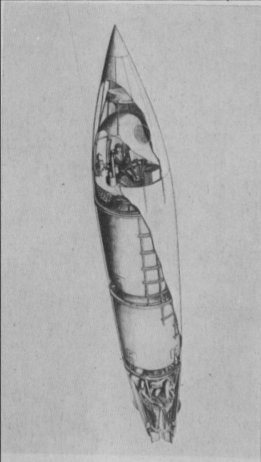
Time Travel Research Center © 2005 Cetin BAL - GSM:+90 05366063183 - Turkey/Denizli
A Manned V2
 |
After the Second World War, Britain, like Russia and America, gained access to the German rocket scientists who had created the V2s which attacked London during the war. While the two post-war superpowers went on to use this information in their rocket and missile programmes, Britain did not. However, one idea put forward just after the war, if it had been adopted, could have changed the history of space exploration totally... On December 23, 1946, a two-man study group of the British Interplanetary Society (R.A. Smith and H. E. Ross) submitted a design for an adapted German V-2 rocket to the Ministry of Supply. The adaption consisted mainly of a pressurised cabin in the nose of the rocket, in place of the usual explosive warhead, which would enable a man to be launched as a passenger on the flight. The cabin was detachable, allowing the astronaut to experience several minutes of weightlessness before it parachuted back to Earth. Unfortunately, the proposal was not adopted, probably due to lack of funds: Britain was still reconstructing after the damage of the war years. However, the concept is almost identical to that used by NASA in 1961, when Astronauts Alan Sheppard and Gus Grissom were sent on sub-orbital flights with a Redstone rocket, going through several minutes of weightlessness. |
| R.A. Smith's drawing of an adapted V2. A passenger is visible in a pressure cabin at the top of the rocket. |
Ana Sayfa · İndex· Ziyaretçi
Defteri
![]() E-Mail
Roket bilimi
E-Mail
Roket bilimi
Time Travel Technology UFO Technology Kuantum Fiziği Kuantum Teleportation